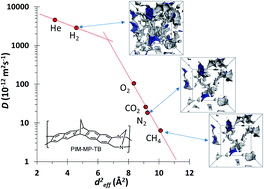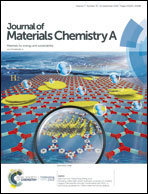The origin of size-selective gas transport through polymers of intrinsic microporosity†
Abstract
An analysis of the diffusivity of light gases through Polymers of Intrinsic Microporosity (PIMs) shows that smaller H2 and He gas molecules have a transport mechanism that is similar to that of porous materials, whereas larger gas molecules, CH4, N2, O2 and CO2, show activated transport similar to that of conventional dense polymers. A typical and defining feature of PIMs, which differentiates their properties from other high free volume polymers, glassy polymers and rubbers, is the change in slope of the plot of the diffusion coefficient as a function of the gas diameter, with a stronger size-selective trend for the larger gas molecules than for He and H2. Deviation from this trend is observed for a polymer-gas combination with strong mutual affinity (i.e. an amine modified PIM with CO2). Molecular modelling shows that size selectivity in PIMs originates from the presence of bottlenecks between the individual free volume elements. For the latest generation of highly rigid PIMs, ageing studies show that diffusivity is differentially reduced for larger gas molecules, thus further enhancing their size-selectivity.



 Please wait while we load your content...
Please wait while we load your content...